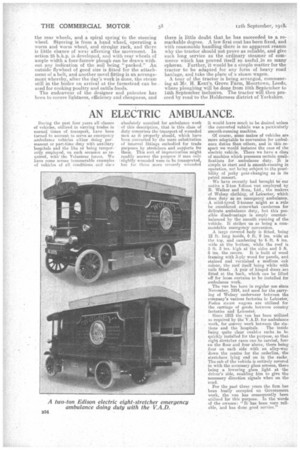AN ELECTRIC AMBULANCE.
Page 14

If you've noticed an error in this article please click here to report it so we can fix it.
During the past four years all classes of vehicles, utilized in varying trades in normal times of transport, have been turned to account to serve as emergen3y ambulance vehicles either doing permanent or part-time duty with auxiliary hospitals and the like or being temporarily employed, on such occasion as required, with the Volunteer forces. We have come across innumerable examplee of vehicles of all conditions and curs
absolutely unsuited for ambulance work of this description, that is this class of duty comprises the transport of wounded Men as it properly should, which have been converted by the mere substitution of internal fittings embodied for trade purposes by etretchers And supports for them. This sort of improvisation might readily' answer the purpose if men only slightly wounded were to be transported, but for those more severely wounded it would leave much to be desired unless the converted vehicle was a particularly smooth-running machine.
Of course, some makes of vehicles are more adaptable to conversion for ambulance duties than others, and in this respect we would instance the ease of the electric vehicle. There we have a Class of Machine which possesses certain quail-. fications for ambulance duty. It is simple to start and is smooth-running in operation, not being subject to the possibility of jerky gear-changing as is its petrol consort.
We have recently had brought to our notice a 2-ten Edison van employed by R. Walker and Sons, Ltd., the makers of WoIeey clothing, of Leicester, which does daty as an emergency ambulance. A sOlid-tyred 2-tonner might as a rule be considered_ somewhat cumbrous for delicate ambulance duty, hut this possible disadvantage is amply counterbalanced by the smooth running of the. vehicle. It strikes .us as being a commendable emergency conversion.
A large covered body is fitted, being 12 ft. long inside, 6 ft_ 9 ins, wide at the top, and cambering to 6 ft. 6 ins. wide at the bottom, while the roof is 5 ft. 3 Ms. high at the sides and 5 ft.
8 ins, the centre. It is built of wood framing with 3-ply wend for panels, and stained and varnished e. medium Oak colour, the roof itself being white with rails fitted. A pair of hinged doors are fitted at the back, which can be lifted
• uff for loose curtains to be installed for ambulance work.
The van has been in regular use since November, 1914, and used for the parrying ef Wolsey underwear between the company's various factories in Leicester: Foelen steam wagons are utilized for the carriage of goods between country factories and Leicester.
8ince 1915 the van has been utilized as required by the V.A.D. for ambulance work, for convoy work between the sta tions and the hospitals. The inside being quite clear enables racks to be quickly installed for the purpose, so that sight stretcher cases can be carried, four • on the floor and four above, there being four on each side with an alley-way down the centre for the orderlies, the stretchers lying end on in the racks. The cab of the vehicle is entirely covered in with the necessary glass screens, there being a lowering glass light at the driver's side, enabling him to give the necessary direction signals when on the road.
Fee the least three years the firm has been busily occupied on Government work, the vais has consequently been utilized for this purpose. In the words of the owners.. "It has been very reliable, and has done good service."






















